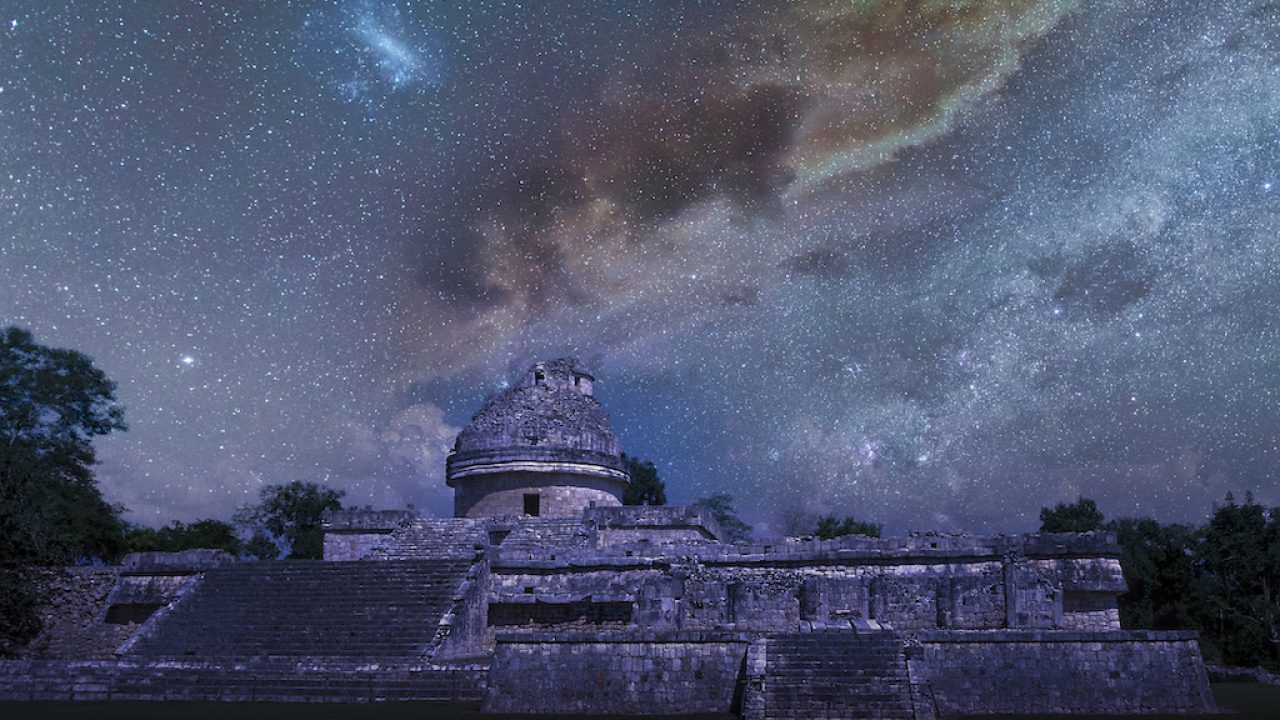The ancient Maya were skilled astronomers, and their knowledge of the stars and planets was reflected in their architecture. Many Mayan buildings were aligned with astronomical events, such as the solstices and equinoxes. This alignment was not just for aesthetic purposes; it was also a way for the Maya to connect with the gods and to mark the passage of time.

One of the most famous examples of Mayan astronomical architecture is Chichen Itza. This ancient city in Mexico is home to many structures that are aligned with the sun, moon, and stars. For example, the Kukulkan Pyramid is aligned with the winter solstice, so that on that day, the sun casts a shadow on the pyramid that resembles the body of a serpent.
El Caracol
Another example of Mayan astronomical architecture is El Caracol, an observatory at Chichen Itza. El Caracol is a round, domed structure with a spiral staircase that leads to the top. From the top, you can see the sun, moon, and planets. El Caracol was used by the Maya to track the movements of the stars and planets, and it is still used by modern astronomers today.
Other buildings
The astronomical influence of Mayan architecture is evident in many other structures as well. For example, the Mayan temples at Tikal are aligned with the sunrise on the equinoxes. The Mayan ball courts are also aligned with astronomical events, and they were used for both religious and sporting purposes.
The Mayans' knowledge of astronomy was extensive, and they used it to build structures that were both beautiful and functional. Their astronomical architecture is a testament to their understanding of the cosmos, and it is a reminder of the importance of astronomy in their culture.
Chichen Itza is one of the most famous archaeological sites in the world, and it is known for its many impressive structures. However, many people do not realize that the site is also a masterpiece of astronomical engineering.
The Maya were skilled astronomers, and they used their knowledge of the stars and planets to align many of the structures at Chichen Itza with astronomical events. For example, the Kukulkan Pyramid is aligned with the winter solstice, so that on that day, the sun casts a shadow on the pyramid that resembles the body of a serpent.
The Maya also used astronomical alignments to mark the passage of time. For example, the ball courts at Chichen Itza are aligned with the equinoxes. This alignment was not just for aesthetic purposes; it was also a way for the Maya to track the seasons and celebrate important religious festivals.
The astronomical influence of Chichen Itza is a testament to the ingenuity and creativity of the Maya. It is a reminder that the Maya were not just people of the past; they were also people who were deeply connected to the cosmos.
The importance of celestial alignment in prehispanic architecture is a well-established fact. Many ancient cultures, including the Maya, the Aztecs, and the Incas, aligned their buildings with astronomical events such as the solstices and equinoxes. This alignment was not just for aesthetic purposes; it was also a way for these cultures to connect with the gods and mark the passage of time. There are several reasons why celestial alignment was so important to prehispanic cultures:
The Maya were particularly skilled at aligning their buildings with astronomical events. For example, the Kukulkan Pyramid at Chichen Itza is aligned with the winter solstice, so that on that day, the sun casts a shadow on the pyramid that resembles the body of a serpent. The Maya also aligned their ball courts with the equinoxes, and they used these courts for both religious and sporting purposes.
The Aztecs also aligned their buildings with astronomical events. For example, the Templo Mayor in Tenochtitlan was aligned with the four cardinal directions, and it was also aligned with the Pleiades star cluster. The Aztecs believed that the Pleiades were associated with the goddess of water, and they aligned their temples with this star cluster in order to ensure that their city would have a plentiful water supply.
The Incas also aligned their buildings with astronomical events. For example, the Coricancha in Cuzco was aligned with the sun, and it was also aligned with the Southern Cross constellation. The Incas believed that the sun was a god, and they aligned their temples with this star in order to bring themselves closer to the gods.
The importance of celestial alignment in prehispanic architecture is a testament to the ingenuity and creativity of these cultures. It is also a reminder that these cultures were deeply connected to the cosmos, and that they believed that the stars and planets played an important role in their lives.
The practice of aligning buildings with celestial forms is not unique to the Maya, the Aztecs, and the Incas. In fact, it is a practice that has been found in many different cultures throughout history. For example, the ancient Egyptians aligned their pyramids with the stars, and the ancient Greeks aligned their temples with the sun.
The reasons why cultures throughout history have aligned their buildings with celestial forms are similar between civilizations: to be closer to their deities, track the seasons, and ensure prosperity in agriculture and politics.
The practice of aligning buildings with celestial forms is a fascinating and complex topic. It is a reminder of the importance of astronomy in many different cultures throughout history, and it is a testament to the ingenuity and creativity of these cultures.
The astronomical influence of Mayan architecture is a fascinating and complex topic. It is a reminder of the importance of astronomy in Mayan culture, and it is a testament to the ingenuity of the Maya. If you are interested in learning more about the astronomical influence of Mayan architecture, I encourage you to visit Chichen Itza or read one of the many books that have been written on the subject.